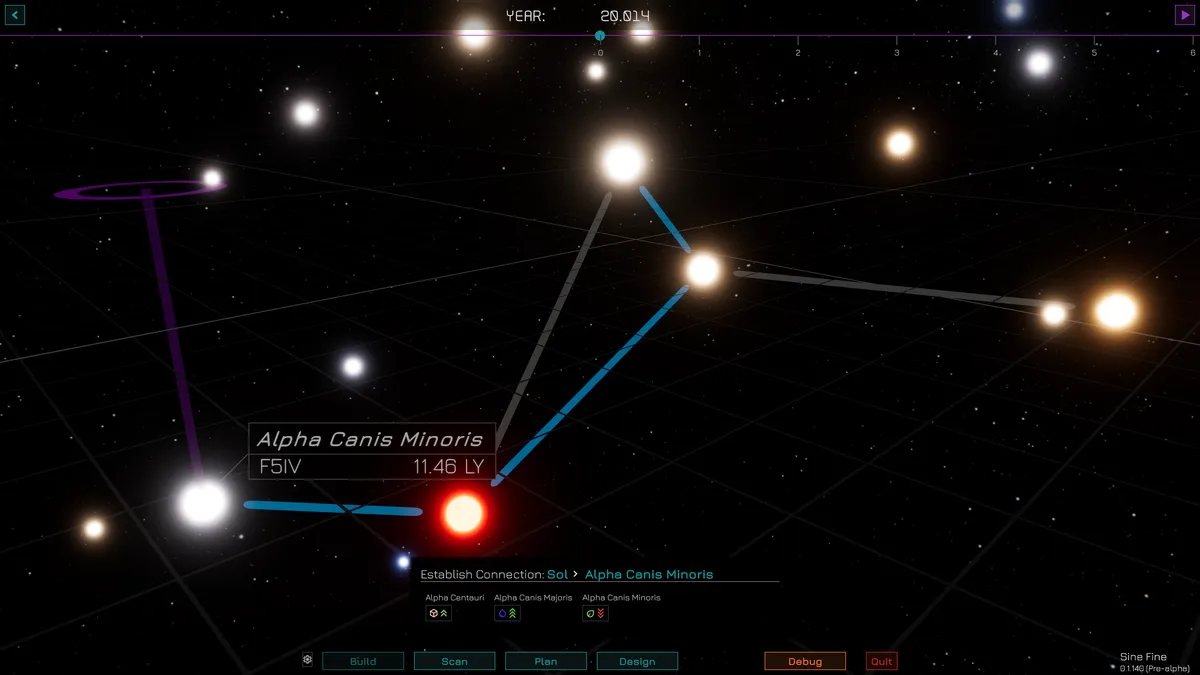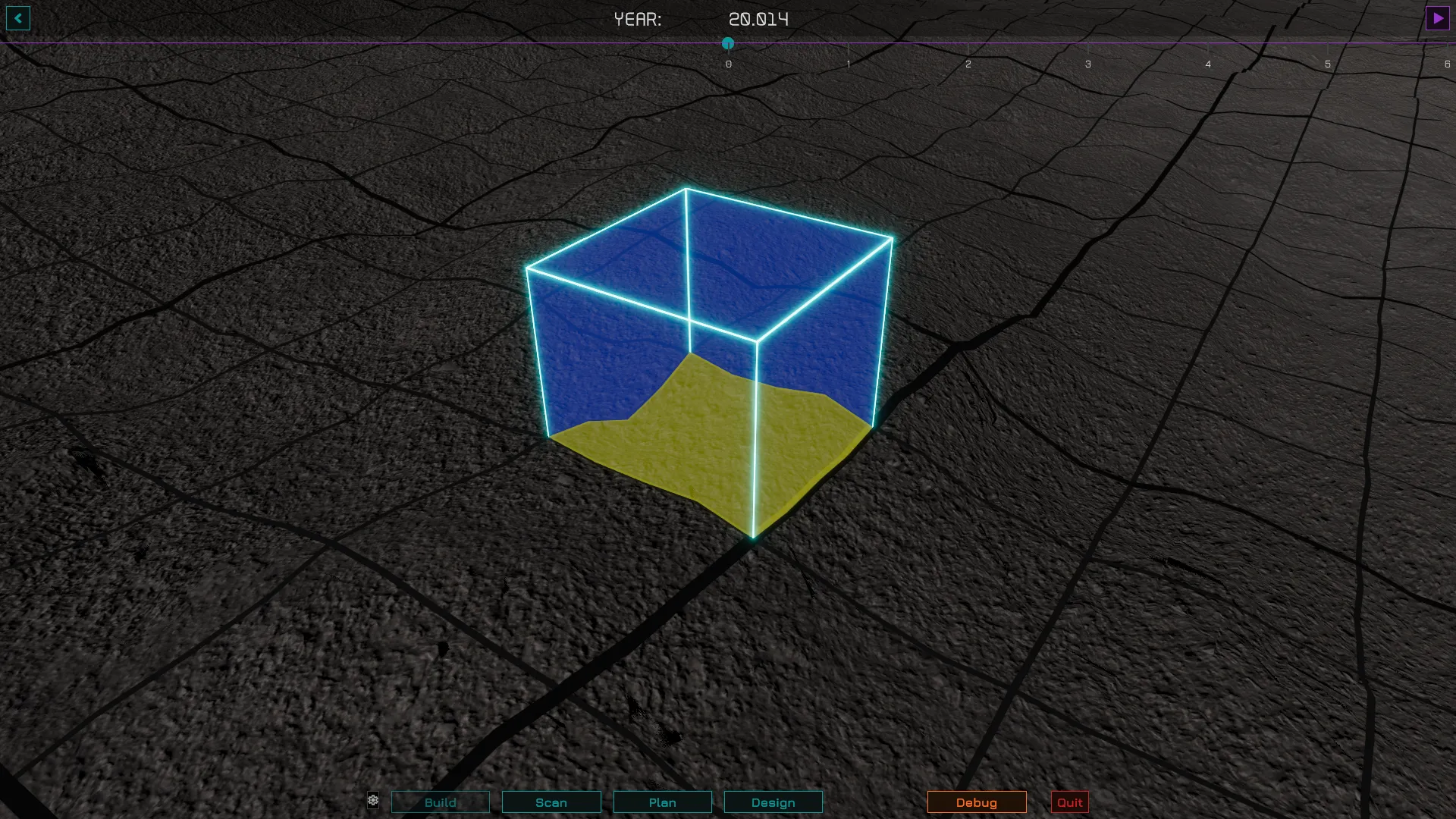
Outpost Development
In Sine Fine the goal is to explore a desolate and seemingly empty galaxy where the player, an artificial consciousness, must find a new habitable planet after humanity’s extinction. Given that both travel and communications work at slower-than-light speeds, how can even a quasi-immortal artificial consciousness manage this almost insurmountable task? After all an outpost on an extrasolar planet is separated from the Solar System by unimaginable distances and, more importantly, time. The player, whose consciousness resides in the Solar System, cannot directly manage the daily operations on another star system. We have to imagine some degree to autonomy to these outposts. But in gameplay terms how will this work?
The answer
The answer was revealed to me in a dream. Well, almost! I had a, let’s say, “epiphany”, while looking out of the window of my bedroom at nighttime. The idea can be summed up as drawing a path connecting the stars to the one where the outpost is, and depending on which stars the player chooses, it will affect how to outpost develops.
The problem
From a story perspective, it would not make sense to have the player directly control every outpost anywhere in the galaxy. The core idea is that at slower-than-light speeds, any “order” coming from the Solar System (where the player AI consciousness is physically located) must first reach the target star system and only then can the order be executed.
Imagining a traditional city-builder gameplay, if we were to build something on an outpost in Alpha Centauri, from the moment we “click” to place the building, we would need to wait at least four years of in-game time before the order can be received and then executed. The further we go from the Solar System, the worse it would get. Of course in the game players can easily accelerate the passage of time, but this would not solve the problem entirely and I would essentially have to design not only a quasi-4x game but also a city-builder, all in the same game.
The solution
I wanted to design a solution that had these characteristics:
- Both “lore”-appropriate and scientifically plausible.
- Would not be a chore for the player but offered an interesting “puzzle”.
- Could be solved in multiple ways to cater to different strategies.
The idea shown in the video is a prototype implementation. It essentially consists in creating a star path connecting the origin (the Solar System) to the destination system where the outpost is or will be built. Each system chosen in the path applies specific effects to the target outpost. Depending on the path chosen, the outpost will develop in a unique way that is the combined result of the connecting stars’ effects.
I am also very deliberately using the word “outpost” instead of “colony”, because Sine Fine is not meant to be a clone of Stellaris. The player is not going to create colonies on other inhabitable planets because only a few human embryos are (hopefully) alive in cryo-stasis, and the success of the mission cannot be risked by making landfall on a dangerous planet. So in the game, the outposts will be true outposts in every sense of the word: small autonomous bases either on the surface or in orbit that address specific goals. For example, acting as a communication relay, research station, or resource extraction.
In gameplay terms, “outpost development” means that these bases will be managed by the game’s AI, who will choose which buildings to build autonomously depending on the characteristics of the site itself. Rather than constantly overriding the outpost’s AI, the player will influence the AI’s strategy by the star path through which they are able to reach the outposts. Every star along the path carries a bit of its “echo” to the target system.
For example, if we imagine that the outpost the player wants to affect is a research base, it would be useful to “route” the signal through other nearby “exotic” systems, such as around a black hole, pulsar, or supernova remnant, in order to “focus” the positive effects on research. If the player then wants to change the focus of this base, they could connect to it through a different path.
Lore-appropriate because whenever the player-AI consciousness decides to build an outpost somewhere in the galaxy, a small part of its “psyche” detaches from itself. Not enough to become independent, but with enough autonomy to manage the operation of the outpost. Every time an outpost is built, the player consciousness becomes a bit more decentralised, which will also play a big role in the game’s story and gameplay.
Scientifically plausible Sending and receiving interstellar signals is an extremely arduous undertaking with today’s knowledge. At interstellar distances, a signal would quickly become background noise. Supposing that at the start of the game the player starts with a sufficient level of technology to enable focused communication within a moderate range (in terms of light years), this calls for the player to explore and build communication relays in multiple star system to enable further exploration of more distant stars.
Puzzle Because the mechanic consists in drawing a 3D graph, it first offers a basic challenge in determining what is the best route to reach the target system. But it also provides other gameplay opportunities such as avoiding “dangerous” regions of space, like nebulas, where the signal could be degraded. Or through alien space, in case there are aliens in the game, who might intercept the signal and discover the player’s location.
Multiple solutions Being a 3D challenge, it is possible to draw multiple star paths to reach a target. Depending on the connected systems, the effect will be unique. It can also be possible to draw specific 3D shapes to discover other unique effects. For example connecting multiple stars to the target in a pyramid shape could lead to a “focus” bonus or redundancy effect. There could be a hidden achievement for connecting all the stars in a known constellation (the name of our game studio should already be a hint on which constellation it might be…).
The way forward
This idea I’m currently prototyping I think has enough potential to become something fun and interesting. There are still a number of challenges such as:
the granularity: this mechanic could work well for connecting systems, but might not be able to distinguish between multiple bases in the same system. However, the galaxy is truly big and the player consciousness’s “sanity” is also meant to represent a limiting factor on how many outpost there can be at any given time.
how to actually translate this into something that works: the AI in 4x games is notoriously not as good as we would like. It is not uncommon that the “colony governor” AI in 4x games is very ineffective. I think that, by imagining that each star along the connecting path represents a “rule” such as “build more of this”, it should be possible to create an AI that actually enacts the player’s orders.
how much direct control to offer to the player: I think the player should still be allowed to directly override the outpost AI. However this needs a more careful solution to avoid scope-creep and necessitating the development of a parallel city-builder game within Sine Fine, as well as micromanagement. My idea is to link any “overrides” to the AI consciousness’ “sanity”. The more it abuses ths possibility, the “madder” it becomes, with adverse effects on gameplay.

What do you think of this system? Let us know in our discord or on /r/SineFine.